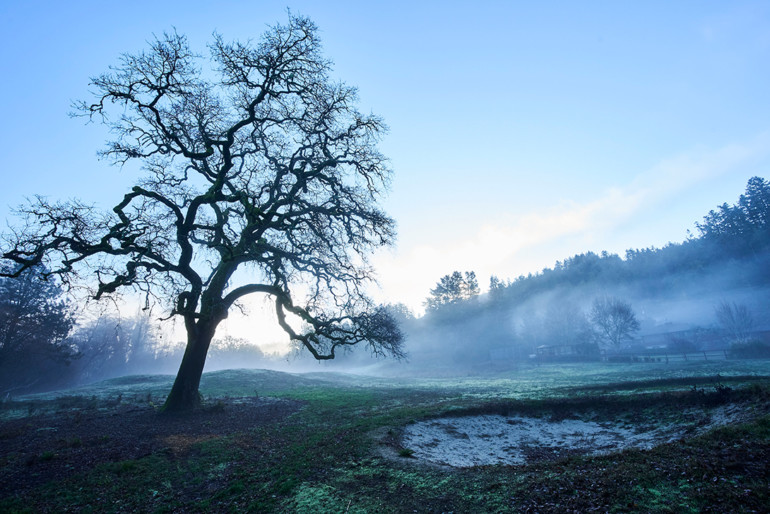WILD SALMON have long been considered sacred by indigenous people on the West Coast. For native ancestors, local streams were full of these wriggling, spawning fish, which provided important nutrition. And though the salmon were feasted on heartily, every year a bounty of them returned.
I worked with these amazing fish for nine years in Alaska, as a fisher and then collecting data on them for that state’s Department of Fish and Game. Their scales can be read like rings on a tree, revealing how long they lived in fresh water and how long in salt. I came to deeply admire the salmon’s powerful resolve to return from the ocean to spawn in its place of birth in rivers and streams. Seals and orcas follow the schools, fishers hunt them ahead of streams, eagles and bears scoop them from rivers, and terns dive on the newly hatched fry (fish) in the fresh water. Over 500 species in the wild eat wild salmon.
Along with steelhead trout, salmon are the only fish that bring nutrients from the sea to the land — literally reversing the energy of a river. They die after they spawn, their decomposed bodies feeding the plankton and stream plants their young will need for food when they hatch. Animals that feed on salmon spread the minerals and nutrients through the land, fertilizing surrounding forests, which sequesters carbon, cleans and filters runoff into rivers, and provides shade for young salmon in the river. The fish are eucharistic in nature, becoming part of the river, the air and the water.
In California, salmon have had a difficult time surviving. Gold miners tore up some river bottoms and covered others with toxic silt, destroying spawning habitat. The Central Valley was transformed from marshes and riparian woodlands to a patchwork of huge farms. Wetlands were drained for orchards and streams were drained so deserts could become grazing grounds. Over 1,500 dams were built on California rivers, the largest being Shasta on the Sacramento River at 602 feet tall. Add the pollution and habit disruption caused by tanneries and other industries dumping into rivers, building of towns, roads, highways and suburban sprawl, vineyards planted on hillsides, and clear-cutting of forests along streams, and it’s evident why chinook and coho salmon, along with steelhead trout, have all but disappeared from many California rivers.
WHAT’S BEING DONE
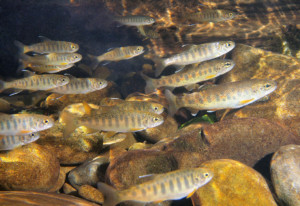
There are signs of hope for the fish. For years in this state, commercial and sport fishers, along with environmentalists, have worked to save salmon and steelhead in the major tributaries and deltas. California Trout, a nonprofit, has lately been working with nongovernmental organizations, scientists and farmers in the Central Valley to manage dormant rice fields as surrogate flood plain habitat for juvenile salmon in the Sacramento River. After the rice fields are harvested, water is diverted from the river to flood the fields. The rice stalks break down, providing food for insects, which are food for juvenile salmon. The fields drain, and bigger, fatter, healthier fish return to the river.
“Recovery of California’s endangered fish populations will be impossible without first recovering the ecological processes that build and sustain functioning aquatic food webs,” says Jacob Katz, California Trout’s lead scientist. “And the food is made on the flood plain. Just like the rest of us, fish do a lot better when they get something to eat. In order for California’s rivers to both support a healthy ecosystem and provide water security for people, the threatened fish populations must regain access to the abundant food resources created on inundated flood plains.”
California Trout is active in Marin, working with landowners and others in Bolinas to explore habitat restoration opportunities for endangered salmon and provide resources and training to boost stream ecology curriculum at Walker Creek Ranch Outdoor School in Petaluma. “Marin is lucky,” says Patrick Samuel, California Trout’s Bay Area program manager. “They have coho and chinook salmon, as well as steelhead trout. Historically those three species would [indeed] have been on the coast and in bay tributaries. Some of the biggest runs were in Corte Madera Creek, Novato Creek, Redwood Creek running through Muir Woods, and Lagunitas watershed.”
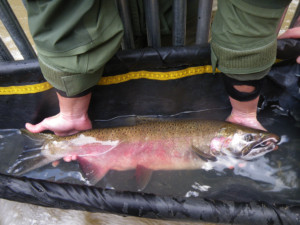
Yet coho salmon populations in California have declined 95 to 98 percent from historic levels, and the fish are listed as endangered under the Federal Endangered Species Act. It is illegal to fish them commercially or recreationally. The largest existing run of coho salmon south of the Noyo River in Fort Bragg is in the Lagunitas Creek watershed, along Sir Francis Drake Boulevard in Marin. Coho numbers have dropped as low as 25 in 2008, a drought year; the current number is about 500.
SPAWN (Salmon Protection and Watershed Network), a local nonprofit operating under the umbrella of Turtle Island Restoration Network, aims to save endangered species from extinction, and it has been working to restore habitat for coho salmon and endangered freshwater shrimp. Its headquarters is near Olema in the ghost town of Jewell, originally created by damming up Lagunitas Creek, with small wood cabins built under the trees for shade. Last year, volunteers and workers for SPAWN hauled out the old dam and housing debris and went to work replanting native trees and shrubs along the creek’s banks.
“These will stabilize erosion and attract insects that coho, chinook and steelhead like to eat,” says Preston Brown, a watershed biologist who works for SPAWN. The crews buried tree trunks at small forks in the creek. “Coho like to have hiding places,” Brown says. “And this creates habitat for endangered freshwater shrimp as well.” It is important to encourage a creek’s natural desire to meander and create forks and calm eddies, he adds; a straight and deep creek with fast water makes it difficult for fish to survive, and the fish can be washed out to sea during heavy rains.
CHANGE IN COURSE
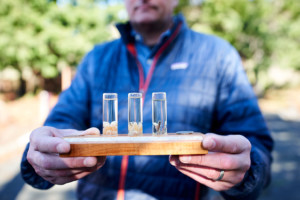
Just upstream, the San Geronimo Golf Course came up for sale in 2017, and environmentalists saw a huge opportunity for a more environmentally friendly use for the site’s 157 acres along San Geronimo Creek, part of the Lagunitas watershed. Advocates hoped this property too could be “rewilded” into habitat for salmon and steelhead, by closing the golf course.
Such closure would be in keeping with a national and statewide trend. According to data from the golf industry analysis group Pellucid Corp., nationwide the number of regular golfers fell from 30 million to 20.9 million between 2002 and 2016, and since millennials statistically are not big on golf, no one expects an uptick anytime soon. In California between 2007 and 2016, 62 golf courses closed, an overall 9 percent decline. Golf courses are expensive to maintain: greens may make sense in rainy Scotland, but places like California see multiyear droughts. Audubon International estimates the average American golf course uses 312,000 gallons of water per day, and keeping the grounds bright green requires lots of chemicals, including pesticides, among them commonly the controversial glyphosate, found in Roundup.
The San Geronimo Course was constructed in 1965, when the Marin Countywide Plan called for building 5,000 new homes for an estimated local population of 20,000. In 1972, a new plan prevented urban development in the San Geronimo Valley. Without the population density needed to sell memberships, the property was converted into a public course.
When the land was put up for sale by the owners in 2017, the Trust for Public Land bought it, intending to transfer it to Marin County Parks and Open Space once TPL secured a grant to repay the purchase price. TPL gathered public input and hired third-party advisers; a bike path, walking path, fire station and salmon restoration were all considered, involving conversations with the national nonprofit Trout Unlimited and an engineering firm specializing in habitat restoration.
But the land transfer and transformation were put on hold after San Geronimo Advocates (SGA), a group of residents seeking to preserve the golf course led by longtime Woodacre resident and real estate agent Niz Brown, filed a lawsuit, citing the California Environmental Quality Act and a lack of transparency in the planning process. As a result, public land use planning was delayed and the county lost grant funding for the purchase and stopped golf operations in 2018 — the course has lain fallow ever since.
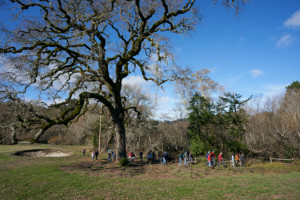
“I appreciated the beauty of the course every day when driving by,” Brown says. “So many special events were held at the clubhouse, like birthday parties, weddings and memorials. It was so beautiful to look out from the clubhouse over the golf course.”
“By shutting down the San Geronimo Golf Course, the county saved over 49 million gallons of water each year,” notes Barbara Bogard, an environmental activist and a board member of the Sierra Club. “We also eliminate the use of pesticides and fertilizers that pollute our water and air.” A report filed by course management with the county indeed had cited use of herbicides, rodenticides, insecticides and fungicides, including Roundup. “Pesticides destroy the soil and biodiversity,” Bogard says. “If we improve creek habitat for endangered salmon and steelhead, we improve it for all wildlife.”
The issue comes to the ballot in March 2020 as Measure D, which would prevent the county from changing the land’s primary use for golfing without first securing voter approval.
Brendan Moriarty, senior project manager at the Trust for Public Land, says the trust considered including a golf course in its restoration plans, but multiple third-party experts held that golf would not be financially sustainable, even on a nine-hole course. “If Measure D is voted down, we can continue to get public input on the best uses,” Moriarty says, “and restore one of the most important salmon runs in the Bay Area, as well as have plans for a much-needed fire station and bike trails that connect the Golden Gate Bridge and Point Reyes.” The clubhouse could be reopened as a community center, he adds.
But “if Measure D passes,” Moriarty says, “it binds our hands: we can’t do meaningful restoration on the property or just about anything else. The county couldn’t authorize a permit for restoration. It [basically] prevents the property from being used for anything but a golf course. And that’s not financially feasible. So it would be limited to a passive open space.” Moreover, holding a popular vote for land use of a specific property is unprecedented, and there’s concern that setting such a precedent could derail environmental restoration projects throughout the state.
Meanwhile, the survival of the salmon hangs in the balance. “The Lagunitas watershed is our geographic anchor for endangered California coast coho recovery,” says Anna Hallagan, a biologist and Trout Unlimited’s North Coast Coho Project Director. “The San Geronimo Creek, which runs through the golf course, is where 40 percent [in the Lagunitas Creek watershed] of adult salmon spawning occurs.”

